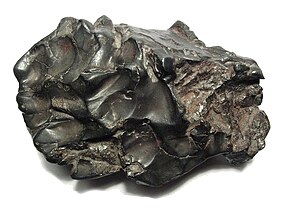IIAB meteorites
| IIAB | |
|---|---|
| — Group — | |
 The Sikhote-Alin is the largest IIAB meteorite. | |
| Compositional type | Iron |
| Structural classification | Hexahedrite to Octahedrite |
| Subgroups |
|
| Parent body | IIAB-IIG[1] |
| Composition | Meteoric iron (Kamacite + Taenite) |
| Total known specimens | 117 + 1 anomalous |
IIAB meteorites are a group of
IIG group.[1]
Naming
Iron meteorite groups are designated with a
Roman numeral and one or two letters. Classification is based on diagrams in which the nickel content of meteoric iron is plotted against certain trace elements (e.g. gallium, germanium and iridium). Clusters in these diagrams are assigned a row (Roman numeral) and a letter in alphabetical order. The first two cluster of the second row, IIA and IIB, were merged when additional measurements connected the two clusters into one, the IIAB group.[4]
Description

All
is formed. IIABs have some of the lowest nickel concentrations of all iron meteorites. They are in the range of 5.3 to 6.6%. For this reason they mostly consist of kamacite with minor amounts of taenite. The two groups that were merged into the IIAB group had different nickel concentrations and therefore different structural classifications. The IIA group has lower nickel concentrations and forms hexahedrites, the IIB has higher nickel concentrations and forms octahedrites.[5]Parent body

The IIAB meteorites formed the metallic core of their parent body before it was destroyed, and some of the fragments reached earth as iron meteorites.
The
IIG meteorites.[1]
Notable specimens
There are currently 117 meteorites classified as IIAB and 1 as IIAB-anomalous. Of these only three were observed falls.
Seven IIAB meteorites weigh more than 1000 kg.[6] The Sikhote-Alin meteorite is the heaviest of these and was an observed fall,[7] while the Old Woman meteorite is, at 38 × 34 × 30 inches (970 × 860 × 760 mm) and 6,070 pounds (2,750 kg) originally, the largest meteorite found in California and the second largest found in the United States.[8]
References
- ^ .
- ISBN 978-0816525621.
- ISBN 0-08-043751-6.
- ISBN 978-0521587518.
- hdl:2060/20020080608.
- ^ "Meteoritical Bulletin Database". Meteoritical Society. Retrieved 6 January 2013.
- ^ "Sikhote-Alin". Meteoritical Society. Retrieved 6 January 2013.
- ^ "Old Woman meteorite". Meteoritical Society. Retrieved 10 January 2013.
